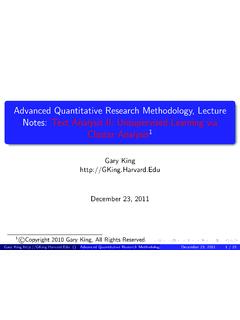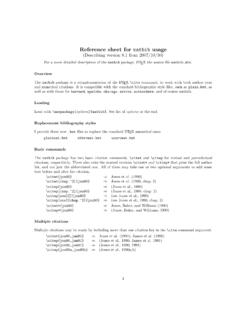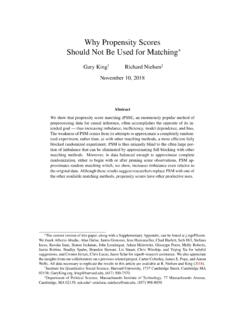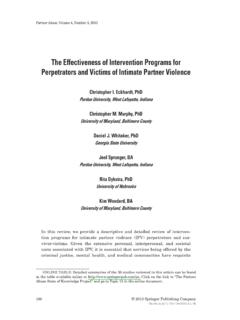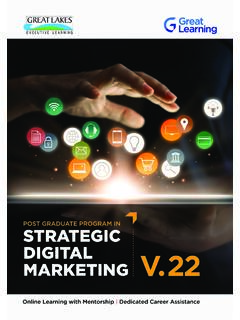Transcription of How Censorship in China Allows Government Criticism but ...
1 American Political Science Review Page 1 of 18 May 2013. How Censorship in China Allows Government Criticism but Silences Collective Expression GARY KING Harvard University JENNIFER PAN Harvard University MARGARET E. ROBERTS Harvard University W. e offer the first large scale, multiple source analysis of the outcome of what may be the most extensive effort to selectively censor human expression ever implemented. To do this, we have devised a system to locate, download, and analyze the content of millions of social media posts originating from nearly 1,400 different social media services all over China before the Chinese Government is able to find, evaluate, and censor ( , remove from the Internet) the subset they deem objectionable.
2 Using modern computer-assisted text analytic methods that we adapt to and validate in the Chinese language, we compare the substantive content of posts censored to those not censored over time in each of 85 topic areas. Contrary to previous understandings, posts with negative, even vitriolic, Criticism of the state, its leaders, and its policies are not more likely to be censored. Instead, we show that the Censorship program is aimed at curtailing collective action by silencing comments that represent, reinforce, or spur social mobilization, regardless of content. Censorship is oriented toward attempting to forestall collective activities that are occurring now or may occur in the future and, as such, seem to clearly expose Government intent.
3 INTRODUCTION Ang 2011, and our interviews with informants, granted anonymity). China overall is tied with Burma at 187th he size and sophistication of the Chinese gov- T ernment's program to selectively censor the expressed views of the Chinese people is un- precedented in recorded world history. Unlike in the of 197 countries on a scale of press freedom (Freedom House 2012), but the Chinese Censorship effort is by far the largest. In this article, we show that this program, designed , where social media is centralized through a few to limit freedom of speech of the Chinese people, para- providers, in China it is fractured across hundreds doxically also exposes an extraordinarily rich source of local sites. Much of the responsibility for censor- of information about the Chinese Government 's inter- ship is devolved to these Internet content providers, ests, intentions, and goals a subject of long-standing who may be fined or shut down if they fail to com- interest to the scholarly and policy communities.
4 The ply with Government Censorship guidelines. To comply information we unearth is available in continuous time, with the Government , each individual site privately em- rather than the usual sporadic media reports of the ploys up to 1,000 censors. Additionally, approximately leaders' sometimes visible actions. We use this new in- 20,000 50,000 Internet police (wang jing) and Inter- formation to develop a theory of the overall purpose of net monitors (wang guanban) as well as an estimated the Censorship program, and thus to reveal some of the 250,000 300,000 50 cent party members (wumao most basic goals of the Chinese leadership that until dang) at all levels of Government central, provincial, now have been the subject of intense speculation but and local participate in this huge effort (Chen and necessarily little empirical analysis.)
5 This information is also a treasure trove that can be used for many other Gary King is Albert J. Weatherhead III University Professor, Insti- scholarly (and practical) purposes. tute for Quantitative Social Science, 1737 Cambridge Street, Har- Our central theoretical finding is that, contrary to vard University, Cambridge MA 02138 ( , much research and commentary, the purpose of the (617) 500-7570. Jennifer Pan is Candidate, Department of Government , Censorship program is not to suppress Criticism of 1737 Cambridge Street, Harvard University, Cambridge MA 02138 the state or the Communist Party. Indeed, despite ( jjpan/) (917) 740-5726. widespread Censorship of social media, we find that Margaret E. Roberts is Candidate, Department of Govern- when the Chinese people write scathing criticisms of ment, 1737 Cambridge Street, Harvard University, Cambridge MA their Government and its leaders, the probability that 02138 ( ).)
6 Our thanks to Peter Bol, John Carey, Justin Grimmer, Navid their post will be censored does not increase. Instead, Hassanpour, Iain Johnston, Bill Kirby, Peter Lorentzen, Jean Oi, we find that the purpose of the Censorship program is to Liz Perry, Bob Putnam, Susan Shirk, Noah Smith, Lynn Vavreck, reduce the probability of collective action by clipping Andy Walder, Barry Weingast, and Chen Xi for many helpful com- social ties whenever any collective movements are in ments and suggestions, and to our insightful and indefatigable under- evidence or expected. We demonstrate these points and graduate research associates, Wanxin Cheng, Jennifer Sun, Hannah Waight, Yifan Wu, and Min Yu, for much help along the way. Our then discuss their far-reaching implications for many thanks also to Larry Summers and John Deutch for helping us to research areas within the study of Chinese politics and ensure that we satisfy the sometimes competing goals of national se- comparative politics.
7 Curity and academic freedom. For help with a wide array of data and In the sections below, we begin by defining two technical issues, we are especially grateful to the incredible teams, and for the unparalleled infrastructure, at Crimson Hexagon (Crim- theories of Chinese Censorship . We then describe our ) and the Institute for Quantitative Social Science unique data source and the unusual challenges involved at Harvard University ( ). in gathering it. We then lay out our strategy for analysis, 1. American Political Science Review May 2013. give our results, and conclude. Appendixes include cod- ment Censorship is aimed at maintaining the status quo ing details, our automated Chinese text analysis meth- for the current regime, we focus on what specifically ods, and hints about how Censorship behavior presages the Government believes is critical, and what actions it Government action outside the Internet.
8 Takes, to accomplish this goal. To do this, we distinguish two theories of what consti- tutes the goals of the Chinese regime as implemented Government INTENTIONS AND THE in their Censorship program, each reflecting a differ- PURPOSE OF Censorship ent perspective on what threatens the stability of the Previous Indicators of Government Intent. Deci- regime. First is a state critique theory, which posits that phering the opaque intentions and goals of the lead- the goal of the Chinese leadership is to suppress dis- ers of the Chinese regime was once the central fo- sent, and to prune human expression that finds fault cus of scholarly research on elite politics in China , with elements of the Chinese state, its policies, or its where Western researchers used Kremlinology or leaders.
9 The result is to make the sum total of available Pekingology as a methodological strategy (Chang public expression more favorable to those in power. 1983; Charles 1966; Hinton 1955; MacFarquhar 1974, Many types of state critique are included in this idea, 1983; Schurmann 1966; Teiwes 1979). With the Cultural such as poor Government performance. Revolution and with China 's economic opening, more Second is what we call the theory of collective action sources of data became available to researchers, and potential: the target of Censorship is people who join to- scholars shifted their focus to areas where informa- gether to express themselves collectively, stimulated by tion was more accessible. Studies of China today rely someone other than the Government , and seem to have on Government statistics, public opinion surveys, inter- the potential to generate collective action.
10 In this view, views with local officials, as well as measures of the collective expression many people communicating on visible actions of Government officials and the govern- social media on the same subject regarding actual col- ment as a whole (Guo 2009; Kung and Chen 2011; Shih lective action, such as protests, as well as those about 2008; Tsai 2007a, b). These sources are well suited to events that seem likely to generate collective action answer other important political science questions, but but have not yet done so, are likely to be censored. in gauging Government intent, they are widely known Whether social media posts with collective action po- to be indirect, very sparsely sampled, and often of du- tential find fault with or assign praise to the state, or bious value.

